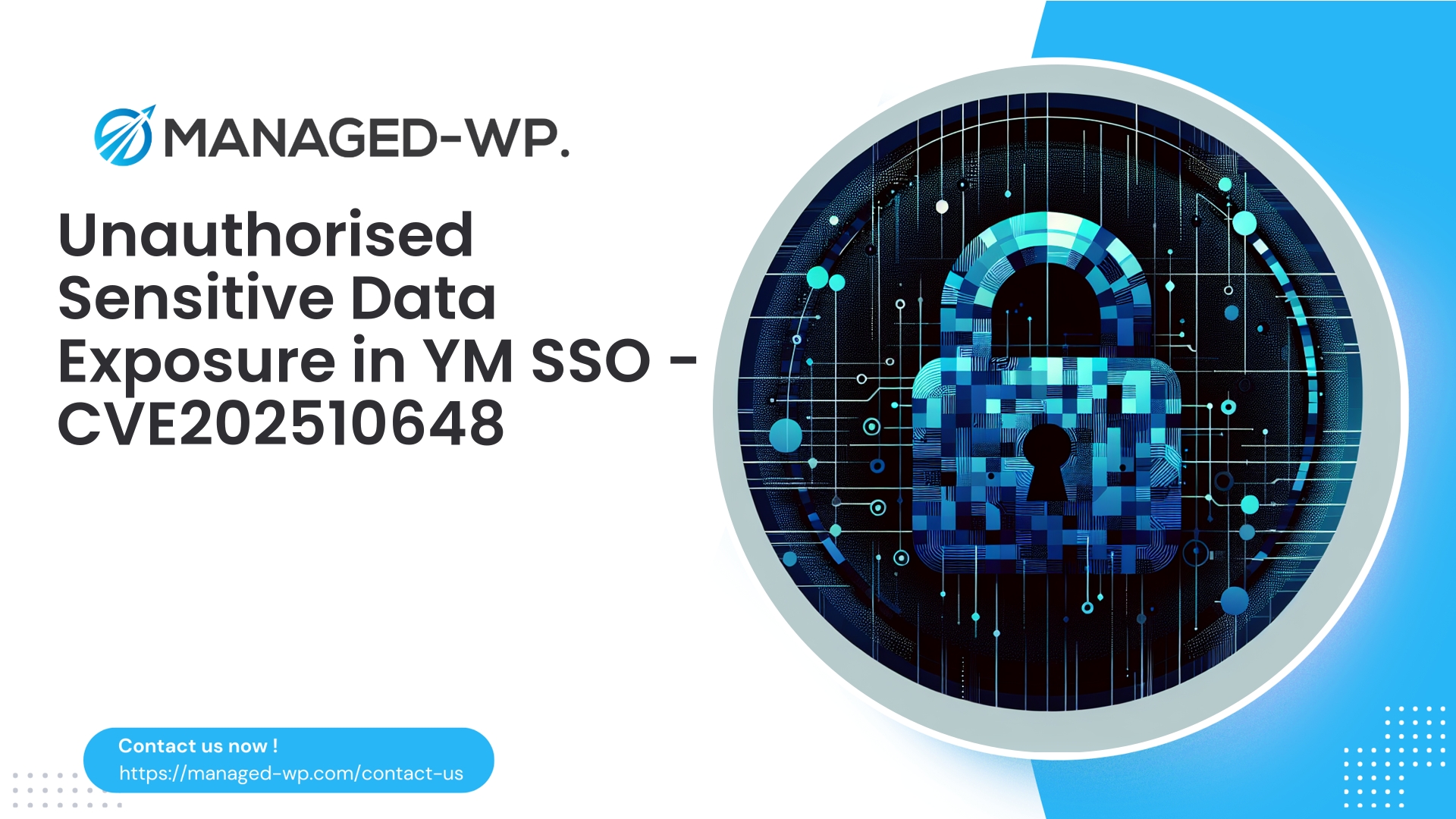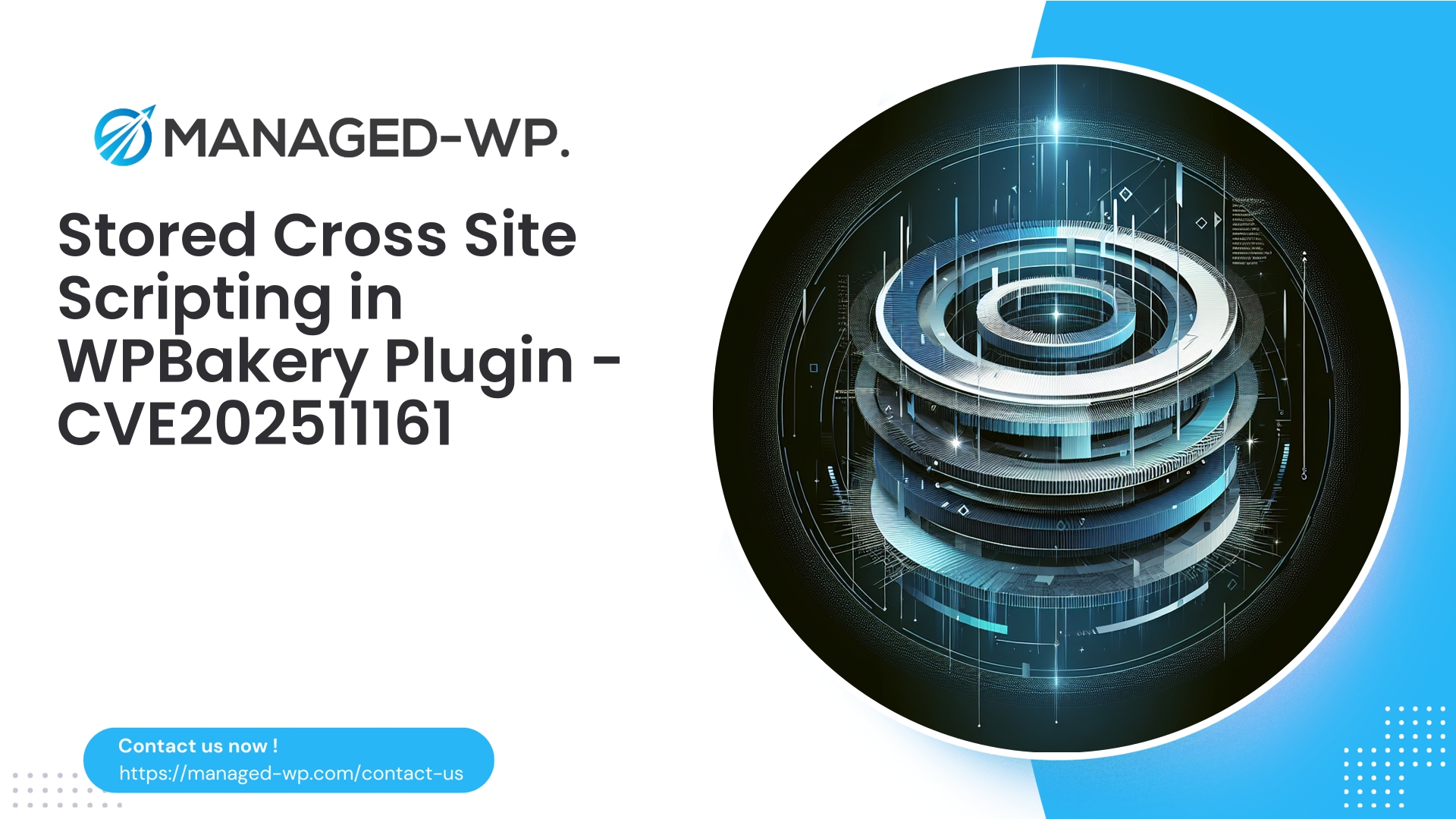| 插件名稱 | 您的會員資格單點登入 |
|---|---|
| 漏洞類型 | 未經身份驗證的資料洩露 |
| CVE編號 | CVE-2025-10648 |
| 緊急 | 低的 |
| CVE 發布日期 | 2025-10-15 |
| 來源網址 | CVE-2025-10648 |
緊急安全警報:YourMembership SSO 外掛程式(≤1.1.7)因缺少授權而洩漏敏感資料(CVE-2025-10648)
來自 Managed-WP 安全專家的深入分析和實用緩解策略
日期: 2025年10月
執行摘要
一個嚴重的存取控制漏洞,已被追蹤為 CVE-2025-10648YourMembership 單一登入 (SSO) WordPress 外掛程式中已發現一個漏洞,該漏洞影響所有版本,包括 1.1.7 及更早版本。此漏洞源自於一個名為 `get_function` 的函數。 moym_display_test_attributes 缺乏適當的授權驗證,可能會使未經身份驗證的攻擊者從受影響的網站中提取敏感資訊。
Managed-WP 的這份安全指南詳細闡述了風險的性質、需要關注的指標以及可採取的緩解措施。指南中包含防火牆規則範例、伺服器設定、開發人員指南、偵測方法以及長期安全最佳實務。在等待官方插件更新期間,我們的託管防火牆和虛擬修補程式服務可以提供至關重要的防禦。
目錄
- 為什麼這個漏洞至關重要
- 漏洞技術分析
- 風險評估和影響情景
- 場地所有者應立即採取的補救措施
- 防火牆規則和伺服器設定範例
- 安全的開發人員補救措施
- 檢測日誌中的漏洞利用嘗試
- 預防未來漏洞的最佳實踐
- Managed-WP 如何保護您的網站
- 立即行動的步驟清單
- 攻擊場景範例
- Managed-WP 安全專家的最終建議
為什麼這個漏洞很重要
存取控制漏洞仍然是 WordPress 外掛程式中最危險的安全缺陷之一。它們允許未經身份驗證或權限較低的攻擊者存取本應明確限制的資料或功能,從而可能導致更嚴重的攻擊。
洩漏的資料可能包括:
- 內部偵錯輸出、API 金鑰、令牌或服務憑證。
- 使用者資訊或敏感配置詳情。
- 插件鉤子無意中暴露的任何管理級資訊。
這 moym_display_test_attributes 該函數缺乏授權強制執行,擴大了攻擊面,使攻擊者能夠在未經身份驗證的情況下探測和提取有價值的資料。
儘管通用漏洞評分系統 (CVSS) 將此漏洞評為中等風險 (5.3),但實際風險取決於特定的網站環境、插件配置以及所涉及的集成,尤其是在您的網站處理會員資訊、單點登入憑證或支付資料的情況下。因此,妥善管理此類漏洞至關重要。
技術概述
- 該函數
moym_display_test_attributes無需驗證使用者權限即可呼叫。 - 這使得未經身份驗證的使用者能夠呼叫原本僅供測試或管理員使用的內部功能。
- 可能洩漏的輸出內容可能包括偵錯資訊、內部屬性或敏感配置變數。
- 受影響版本:YourMembership 單一登入外掛程式 1.1.7 及之前的所有版本。
- 官方 CVE 識別碼:CVE-2025-10648
筆記: 本安全公告不涉及漏洞利用程式碼的發布。相反,我們側重於防禦策略和適當的補救措施。
影響情境和風險評估
潛在的直接後果
- 敏感配置資料(例如 API 令牌和端點)洩漏。
- 洩漏內部插件變量,幫助攻擊者自訂後續攻擊。
- 與其他漏洞結合時風險會放大,可能導致網站被攻破。
主要風險因素
- 儲存會員個人識別資訊 (PII) 的網站面臨更大的風險。
- 與支付處理商、CRM 系統或分析平台整合的網站可能會洩漏憑證。
- 多站點管理人員必須高度重視並優先處理此漏洞。
CVSS評分解釋(5.3)
- 雖然 CVSS 評分反映出中等嚴重程度,但資訊外洩後,實際威脅等級可能會迅速升級。
- 資訊外洩是憑證濫用或權限提升等更具破壞性攻擊的前兆。
網站所有者應立即採取的行動
如果您正在使用安裝了 YourMembership 單一登入外掛程式的 WordPress 網站,請立即執行以下步驟:
- 確定受影響的安裝: 請確認插件版本;版本≤1.1.7有漏洞。
- 立即更新插件: 如果有已修復的版本,請立即安裝。
- 如果沒有補丁: 考慮暫時在面向公眾的網站上停用該插件。
- 實施存取控制: 使用伺服器或防火牆規則阻止對下列物件的調用
moym_display_test_attributes. - 監控日誌: 檢查訪問日誌中是否存在引用該函數的異常請求。
- 採用虛擬補丁: 利用託管防火牆或WAF解決方案即時阻止攻擊嘗試。
- 對疑似安全漏洞做出反應: 隔離受影響的站點,收集日誌,審核使用者帳戶,並根據需要從乾淨的備份中復原。
推薦的防火牆和伺服器規則
以下是經過測試的防禦配置,可阻止未經授權的呼叫易受攻擊函數的嘗試。部署前請在測試環境中進行自訂和測試。
ModSecurity 規則範例
SecRule REQUEST_URI|ARGS "@rx moym_display_test_attributes" "id:1001001,phase:1,deny,log,status:403,msg:'阻止了對 moym_display_test_attributes 的呼叫'"
NGINX 配置
如果 ($request_uri ~* "moym_display_test_attributes") { 回傳 403; } 如果 ($arg_moym_display_test_attributes) { 回傳 403; }
Apache .htaccess 規則
RewriteEngine On RewriteCond %{QUERY_STRING} moym_display_test_attributes [NC,OR] RewriteCond %{REQUEST_URI} moym_display_test_attributes [NC] RewriteRule .* - [F]
WordPress MU外掛程式碼片段(適用於無法存取伺服器的環境)
add_action('init', function() { $needle = 'moym_display_test_attributes'; $uri = $_SERVER['REQUEST_URI'] ?? ''; $qs = $_SERVER[]] $needle) !== false || stripos($qs, $needle) !== false) { status_header(403); exit; } }, 0);
筆記: 這只是權宜之計,並非長久之計。
開發商補救指南
插件開發者應實施以下安全編碼措施:
- 移除所有測試或調試功能 來自生產插件程式碼。
- 嚴格執行能力檢查: 例如,
current_user_can('manage_options')限制敏感功能。 - 使用正確的權限回呼函數連接 REST API 端點:
register_rest_route( 'moym/v1', '/test-attributes', array( 'methods' => 'GET', 'callback' => 'moym_display_test_attributes', 'permission_callback' => function() { return current__cancan(s');
- 使用 nonce 保護 AJAX 操作: 要求
check_ajax_referer('moym_nonce', 'security'). - 轉義所有輸出: 使用
esc_html(),esc_attr(), 或者wp_json_encode()視情況而定。 - 對傳回的資料進行清理和最小化處理: 避免洩漏內部狀態或原始偵錯值。
- 發布前移除調試端點: 建立一份以安全性為重點的發布檢查清單。
安全處理程序範例:
function moym_display_test_attributes() { if ( ! is_user_logged_in() || ! current_user_can( 'manage_options' ) ) { wp_send_json_error( 'Unauthorized', 403 );此處僅公開經過清理的非敏感資訊。 ]; wp_send_json_success( $output ); }
偵測攻擊嘗試
網站管理員應仔細檢查伺服器日誌,以尋找針對易受攻擊功能的可疑活動:
- 包含請求
moym_display_test_attributes在 URL、查詢參數或 POST 請求中。 - 來自單一 IP 位址的異常 GET 請求掃描多個站點。
- 請求中包含異常或缺失的用戶代理標頭。
- 對於需要身份驗證的端點,出現了意料之外的 200 OK 響應。
日誌搜尋命令範例:
grep -i "moym_display_test_attributes" /var/log/nginx/access.log grep -i "moym_display_test_attributes" /var/log/php_errors.log
如果偵測到可疑活動,請仔細記錄時間戳記、IP 位址和使用者代理資訊。暫時封鎖違規 IP 位址,如果懷疑有資料洩露,請將事件升級至安全回應部門。
降低未來風險的最佳實踐
- 保持插件清單的最新狀態: 追蹤各個環境中的插件及其版本。
- 實施暫存和發布控制: 防止調試/測試程式碼進入生產環境。
- 遵循最小特權原則: 確保外掛程式強制執行最低存取權限要求。
- 使用託管式 WAF 和虛擬修補程式: 在官方修復程式發布之前,抵禦已知漏洞。
- 定期進行安全掃描和日誌監控。
- 採用安全編碼標準: 始終如一地使用能力檢查、隨機數、權限回調和輸出轉義。
Managed-WP 如何保護您
當出現此類危險漏洞時,Managed-WP 可提供即時的多層安全保護,旨在降低風險,同時您可以解決根本原因:
- 託管防火牆和網路應用防火牆: 我們快速部署客製化規則,以阻止針對暴露外掛功能的攻擊嘗試。
- 虛擬補丁(專業版): 當官方修補程式不可用時,虛擬修補程式可以透過攔截惡意請求來提供零日漏洞防護。
- 持續惡意軟體掃描: 偵測到表明網站已被入侵的可疑修改。
- 低衝擊配置: 我們的防禦措施在伺服器層和請求邊緣高效運行,以保持最佳的網站效能。
使用會員制、單一登入或外部整合的網站尤其能從 Managed-WP 的主動保護功能中受益,防止資訊外洩風險演變成全面資料外洩。
立即保護您的網站安全—免費託管防火牆 + WAF
使用 Managed-WP 的安全防護服務非常簡單。我們的免費方案可立即為您提供必要的安全工具:
- 基礎版(免費): 託管防火牆、無限頻寬、Web 應用防火牆 (WAF)、惡意軟體掃描器以及針對常見 OWASP Top 10 威脅的緩解措施。
- 標準($50/年): 新增自動惡意軟體清除和IP清單管理功能。
- 專業版($299/年): 包括每月報告、漏洞自動虛擬修補和進階支援。
請在此註冊: https://my.wp-firewall.com/buy/wp-firewall-free-plan/
筆記: 即時WAF和惡意軟體掃描保護讓您可以專注於安全地打補丁,而無需承受攻擊流量的壓力。
您的立即行動清單
- 存貨: 找到所有安裝了存在漏洞的 YourMembership SSO 插件的網站,並檢查其版本。
- 修補: 如果存在修復版本,請立即套用更新。
- 禁用: 暫時停用無法進行修補的插件。
- 防火牆: 按照上述建議部署 WAF 和伺服器規則。
- 監視器: 查看通話記錄,尋找可疑通話的證據
moym_display_test_attributes. - 堵塞: 暫時封鎖違規IP位址,等待調查結果。
- 掃描: 對惡意軟體進行全面掃描,檢查是否有入侵跡象。
- 備份: 採取補救措施後,進行安全乾淨的備份。
- 硬化: 在自訂程式碼中強制執行嚴格的權限和能力檢查。
- 考慮託管式保護: 如果無法立即修復,請啟用 Managed-WP 的防火牆和虛擬修補程式功能。
攻擊場景範例
攻擊者經常掃描網路尋找有漏洞的插件。一旦發現某個網站安裝了版本低於 1.1.7 的 YourMembership 單一登入插件,他們就會利用這些未受保護的漏洞。 moym_display_test_attributes 此功能用於提取敏感的內部屬性資料。然後,利用這些資訊策劃有針對性的後續攻擊,例如憑證噴灑、網路釣魚活動或探測其他內部端點,從而增加發生嚴重安全漏洞的可能性。
對這個初始暴露階段實施封鎖,可以有效地關閉一個關鍵的偵察途徑,從而顯著幹擾攻擊者的策略。
來自託管 WordPress 安全專家的最後說明
此類存取控制漏洞通常是由於開發規範不足或發布流程不當造成的。雖然外掛程式作者對程式碼安全負有主要責任,但網站所有者也必須建立安全至上的理念——定期檢查外掛程式、實施嚴格的控制措施並監控異常情況。
管理多個 WordPress 網站需要具備自動化漏洞掃描和虛擬修補功能。雖然託管式 WAF 服務無法取代安全編碼,但它提供了一層至關重要的防禦屏障,能夠在永久性修復程序準備就緒的同時,阻止自動化掃描和攻擊嘗試。
如果您在實施緩解措施、配置防火牆規則或根據您的環境自訂保護措施方面需要專家協助,Managed-WP 可提供全面的支援。我們的免費方案可提供即時的基礎安全保障,讓您在壓力下也能果斷行動。
保持警惕,及時更新,並將任何意外的面向公眾的管理功能視為重大事件。
— Managed-WP 安全團隊



















